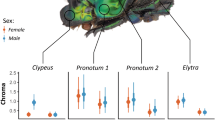Abstract
Fourteen body measurements of 132 adult female camels belonging to three populations Guerzni (60), Khouari (28), and Marmouri (44) reared in 38 herds of 8 provinces of Southern Morocco were studied to identify homogeneous groups according to their conformation. The measurements were chest girth (CG), hump girth (HG), height at withers (HW), body length (BL), fore limb length (FLL), chest width (CW), chest depth (CD), fore hoof circumference (FHC), head length (HL), distance between eyes (DE), ear length (EL), neck length (NL), neck circumference (NC), and tail length (TL). The three populations were compared according to their mean body measurements and through multivariate analyses. The results revealed that only HG, HW, BL, and FLL were significantly influenced by the population. Moreover, the MANOVA showed that Guerzni and Marmouri populations were significantly different, whereas Khouari was not significantly different either from Guerzni or Marmouri populations. Discriminant analysis showed that out of 14 variables, BL and FLL were the most discriminant and resulted into two significant canonical variables (CAN1 and CNA2). Khouari population could be best discriminated from Guerzni and Marmouri by CAN1, and Guerzni could be best distinguished from Marmouri by CAN2. The discriminant analysis revealed that 46.7%, 60.7%, and 40.9% of Guerzni, Khouari, and Marmouri animals, respectively, were correctly classified in their original population. The clustering of the three populations highlighted two Moroccan camel groups: Guerzni and Marmouri in the first group and Khouari in the second one.



Similar content being viewed by others
References
Abdallah, H.R., Faye, B., 2012. Phenotypic classification of Saudi Arabian camel (Camelus dromedarius) by their body measurements, Emirates Journal of Food and Agriculture, 24 (3), 272–280
Achaaban, M.R., Ouragh, L., Ouassat, M., 1999. Characterization of Moroccan camel's population. Final report of Camel Applied Research and Development Network (CARDN) Project: Study and practical research in the field of camel livestock. Hassan II Institute of Agronomy and Veterinary Medicine, Rabat, Morocco. 58.
Babelhadj, B., Benaissa, A., Adamou, A., Tekkouk-Zemmouchi, F., Raache, S., Babelhadj, T., Guintard, C., 2017. Approche morphozoométrique de chamelles (Camelus dromedariusL.) des populations algériennes Sahraoui et Targui, Revue d’Élevage et de Médecine vétérinaire des Pays tropicaux ,70 (2), 65–69
Chniter, M., Hammadi, M., Khorchani, T., Krit, R., Benwahada, A., Ben Hamouda, M., 2013. Classification of Maghrebi camels (Camelus dromedarius) according to their tribal affiliation and body traits in southern Tunisia, Emirates Journal of Food and Agriculture, 25 (8), 625–634
Ezzahiri, A., 1988. Les races de dromadaires élevées dans la zone d’Ouarzazate. Rapport ORMVA d’Ouarzazate, Morocco
FAO, 2012. Phenotypic characterization of animal genetic resources. Animal Production and Health Guidelines, No. 11, Rome. (available at http://www.fao.org/docrep/015/i2686e/i2686e00.htm). Accessed 21 May 2014
Ishag, I.A., Eisa, M.O., Ahmed, M.-K.A., 2011. Phenotypic characteristics of Sudanese camels (Camelus dromedarius), Livestock Research for Rural Development, 23 (4)
Ministry of Agriculture, 2018. The camel sector as part of the Moroccan green plan. The 5th ISOCARD Meeting, 12–15 November 2018, Laâyoune, Morocco
Oulad Belkhir, A., Chehma, A., Faye, B., 2013. Phenotypic variability of two principal Algerian camel’s populations (Targui and Sahraoui), Emirates Journal of Food and Agriculture, 25 (3), 231–237
SAS, 2008. Statistical Analysis System, Version 9.2, SAS Institute Inc., Cary, NC, USA
Tandoh, G., Gwaza, D.S., 2017. Sex dimorphism in the one hump-camel (Camelus dromedarius) from selected populations in Nigeria, Journal of Applied Life Sciences International, 15(3), 1–10
Yosef, T., Kefelegn, K., Mohammed, Y.K., Mengistu, U., Solomon, A., Tadelle, D., Han, J., 2014. Morphological diversities and eco-geographical structuring of Ethiopian camel (Camelus dromedarius) populations, Emirates Journal of Food and Agriculture, 26 (4), 371–389
Acknowledgements
This study has been achieved within the CARAVAN project (ARIMNET2).
We thank all staff of DRA of Laâyoune - Sakia El Hamra, DRA of Guemim - Oued Noun and ONSSA of South regions of Morocco for their support and assistance during data collection. We thank all camel owners and shepherds who allowed us to measure their animals.
Author information
Authors and Affiliations
Corresponding author
Ethics declarations
Conflict of interest
The authors have no conflict of interests regarding the research reported in this manuscript.
Additional information
Publisher’s note
Springer Nature remains neutral with regard to jurisdictional claims in published maps and institutional affiliations.
Rights and permissions
About this article
Cite this article
Boujenane, I., El Khattaby, N., Laghouaouta, H. et al. Morphological diversity of female camel (Camelus dromedarius) populations in Morocco. Trop Anim Health Prod 51, 1367–1373 (2019). https://doi.org/10.1007/s11250-019-01813-5
Received:
Accepted:
Published:
Issue Date:
DOI: https://doi.org/10.1007/s11250-019-01813-5




